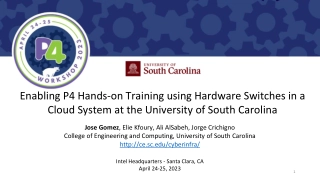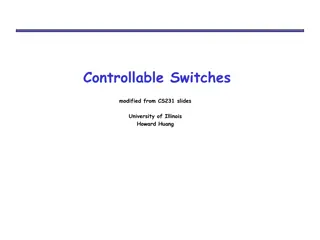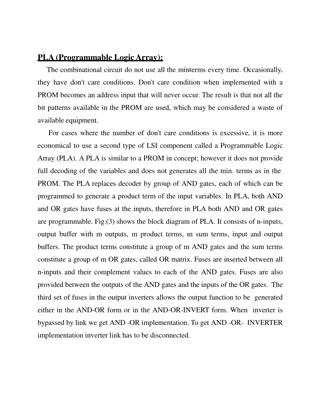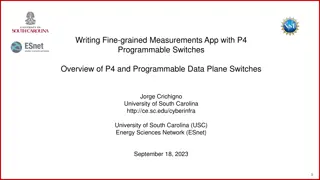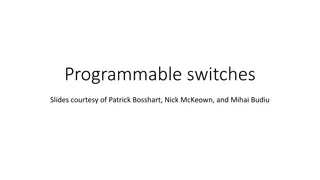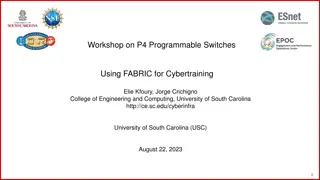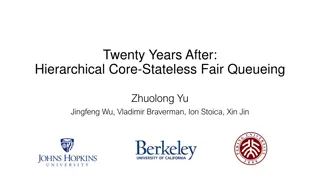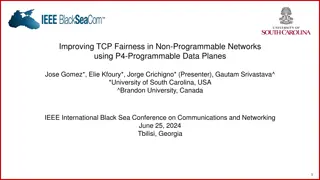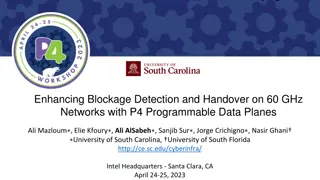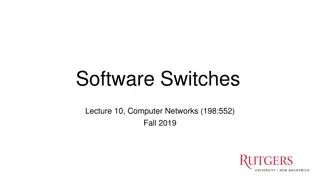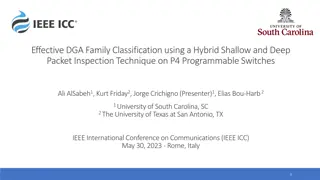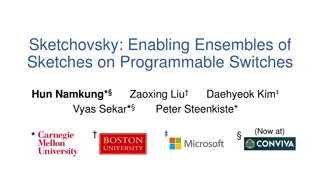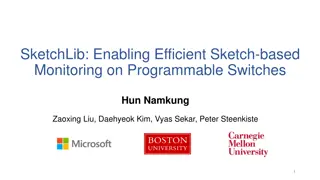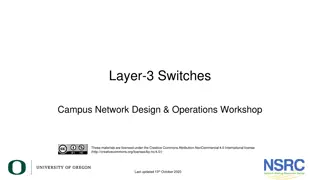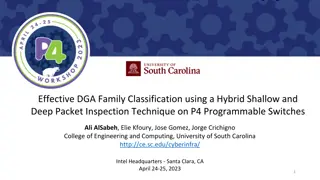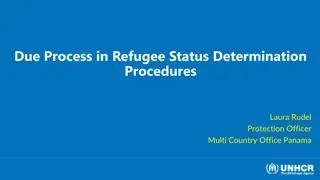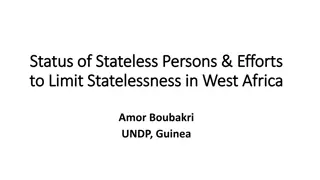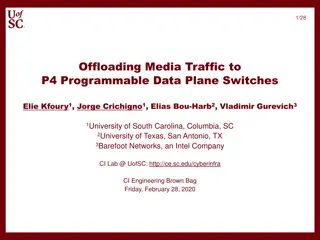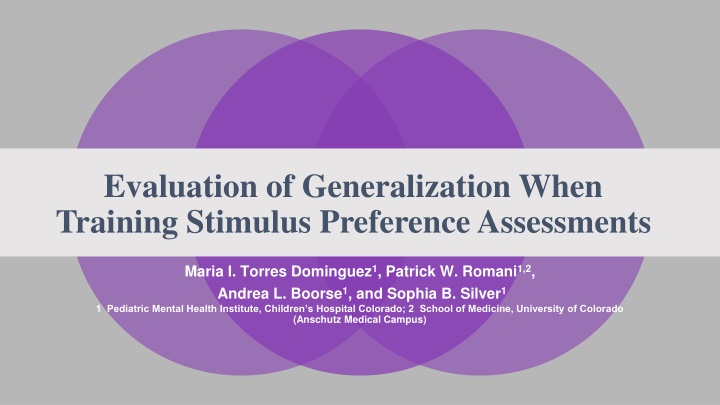
Challenging the Stateless Quo of Programmable Switches
This study delves into the Protocol Independent Switch Architecture (PISA) and its impact on networking, discussing its architecture, features, and enabling in-network applications for improved performance.
Download Presentation

Please find below an Image/Link to download the presentation.
The content on the website is provided AS IS for your information and personal use only. It may not be sold, licensed, or shared on other websites without obtaining consent from the author. If you encounter any issues during the download, it is possible that the publisher has removed the file from their server.
You are allowed to download the files provided on this website for personal or commercial use, subject to the condition that they are used lawfully. All files are the property of their respective owners.
The content on the website is provided AS IS for your information and personal use only. It may not be sold, licensed, or shared on other websites without obtaining consent from the author.
E N D
Presentation Transcript
Evaluation of Generalization When Training Stimulus Preference Assessments Maria I. Torres Dominguez1, Patrick W. Romani1,2, Andrea L. Boorse1, and Sophia B. Silver1 1 Pediatric Mental Health Institute, Children s Hospital Colorado; 2 School of Medicine, University of Colorado (Anschutz Medical Campus)
The use of positive reinforcement in the context of behavioral treatment is a common and important practice (Karsten & Carr, 2009). To identify positive reinforcers, stimulus preference assessments are often used MSWO (DeLeon & Iwata, 1996) Paired Stimulus (Fisher et al., 1992) Single Stimulus (Pace et al., 1985) Competing Stimulus (Piazza et al., 1998) Free Operant (Roane et al., 1998) Introduction
Preference Assessments Single Stimulus Paired Stimulus Multiple Stimulus Without Replacement (MSWO) Free Operant Competing Stimulus
Fisher, W., Piazza, C. C., Bowman, L. G., Hagopian, L. P., Owens J. C., & Slevin, J. (1992). A comparison of two approaches for identifying reinforces for persons with severe and profound disabilities. Journal of Applied Behavior Analysis. 24, 491-498. doi: 10.1901/jaba.1992.25-491
Fisher, W., Piazza, C. C., Bowman, L. G., Hagopian, L. P., Owens J. C., & Slevin, J. (1992). A comparison of two approaches for identifying reinforces for persons with severe and profound disabilities. Journal of Applied Behavior Analysis. 24, 491-498. doi: 10.1901/jaba.1992.25-491
Fisher, W., Piazza, C. C., Bowman, L. G., Hagopian, L. P., Owens J. C., & Slevin, J. (1992). A comparison of two approaches for identifying reinforces for persons with severe and profound disabilities. Journal of Applied Behavior Analysis. 24, 491-498. doi: 10.1901/jaba.1992.25-491
Training others Roscoe and Fisher (2008) taught direct-care staff to implement the paired stimulus and MSWO preference assessments. Behavioral skills training (BST)(Parsons, Rollyson, & Reid, 2012) Modeling correct implementation of the procedure Followed by immediate feedback and rehearsal First reviewing instructions We conducted a literature review to identify what preference assessments are most commonly taught to direct-care staff. Out of 10 studies, 8 taught the MSWO, 7 taught the paired stimulus, 3 taught the free operant, and no studies taught the single stimulus or competing stimulus assessment.
Study Objectives How many preference assessments need to be trained before participant shows improvement on untrained preference assessments? Does teaching certain preference assessments interfere with acquisition of skills for the other preference assessments?
Method: Participant and Setting Participant: Mental health counselor No prior experience with applied behavior analysis or implementing preference assessments Setting: Therapy room (6.0 m x 6.0 m) a table and two chairs.
Experimental Design The current study took place within a multiple probe across preference assessments design (Kennedy, 2005).
Experimental Design
Experimental Design
Experimental Design
Protocol integrity was defined as steps on the preference assessment protocols correctly implemented. These data were represented as a percentage (frequency of correct implementation divided by frequency of correct plus incorrect implementation multiplied by 100). Dependent Variables
Procedures : Main Study Procedures : Main Study
Protocol restricted from participant. Materials given to participant to implement preference assessment. Participant was given preference assessment protocol Baseline: Experimenter responded to the participant s implementation of the assessment based on a confederate protocol. After finishing assessment, participant graphed and interpreted data.
Behavioral Skills Training (Parsons, Rollyson, & Reid, 2012) 1 2 3 Experimenter modeled each step of the targeted preference assessment and had participant practice until they implemented steps without assistance. Participant struggled to implement the paired stimulus the most Experimenter described and provided written description of each step of protocol. Answered any questions participant had.
Maintenance Same procedures as Baseline.
Procedures: Retrospective Study Created Excel spreadsheet listing each step for each preference assessment in separate columns. Entered data on whether each step was implemented correctly or incorrectly for each session. We divided data into conditions marked by the specific combination of assessments that had been taught and mastered by the participant. Calculated percentage of times each step was implemented correctly to evaluate generalization of responding and potentially interfering conditions.
Discussion BST effectively increased procedure integrity for the paired stimulus and MSWO preference assessments, which replicated previous research (Roscoe & Fisher, 2008).
Discussion For this participant, training on two preference assessments (paired stimulus and MSWO assessments) were needed before generalization to untrained preference assessments occurred.
Discussion Following training on the paired stimulus preference assessment: Reliable decreases in restricting the selected toy and moving the toys during the MSWO assessment occurred.
Discussion Following training on paired stimulus and MSWO preference assessments: Reliable decreases in having the toy available for 30 s occurred during the competing stimulus assessment.
Future prospective, study might evaluate a training package consisting of forced-choice preference assessments (paired stimulus and MSWO) with specific emphasis on when to restrict stimuli, move stimuli, and how long to have stimuli available for. A second participant that needed to be trained on two preference assessments before generalization occurred demonstrated similar results. Discussion
Limitation & Next Steps A limitation of the current investigation was that we conducted this analysis for only two participants out of the five. Future research should recruit additional participants to evaluate the current project s research questions.
References DeLeon, I. G., and Iwata, B. A. (1996). Evaluation of a multiple- stimulus presentation format for assessing reinforcer preferences. Journal of Applied Behavior Analysis. 29, 519-533. doi: 10.1901/jaba.1996.29-519 Fisher, W., Piazza, C. C., Bowman, L. G., Hagopian, L. P., Owens J. C., and Slevin, J. (1992). A comparison of two approaches for identifying reinforces for persons with severe and profound disabilities. Journal of Applied Behavior Analysis. 24, 491-498. doi: 10.1901/jaba.1992.25-491 Pace, G. M., Ivancic, M. T., Edwards, G. L., Iwata, B. A., and Page, T. J.(1985). Assessment of stimulus preference and reinforcer value with profoundly retarded individuals. Journal of Applied Behavior Analysis.18, 249 225. doi: 10.1901/jaba.1985.18-249 Piazza, C.C., Fisher, W. W., Hanley, G. P., LeBlanc, L. A., Worsdell, A. S., Lindauer, S. E., and Keeney, K. M.(1998).Treatment of pica thorough multiple analyses of its reinforcing functions. Journal of Applied Behavior Analysis. 31, 165-189. doi: 10.1901/jaba.1998.31-162 Roane, H. S., Vollmer, T. R., Ringdahl, J. E., and Marcus, B. A. (1998). Evaluation of a brief stimulus preference assessment. Journal of Applied Behavior Analysis. 31, 605-620. doi: 10.1901/jaba.1998.31-605
Acknowledgements Mentor Patrick W. Romani, Ph.D., BCBA-D Directors MerlinAriefdjohan, PhD, MPH Emmaly Perks, MA Sponsors Dr. Dominic Martinez (Office of Diversity and Inclusion, CCTSI, UCD) Dr. Douglas Novins and Dr. Jennifer Hagman (PMHI, CHCO) PURPLE Cohort

